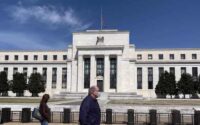From the US to Europe and Hong Kong, commercial real estate has become the focus for investors trying to predict the next crisis after a decade of cheap borrowing came to an abrupt end. A cocktail of challenges has emerged for the world’s biggest asset class. The problems vary from region to region and encompass office buildings and shopping malls. The risk is that these simultaneous troubles lead to a bigger shakeout that jolts the industry’s lenders and leaves city centers pockmarked with empty buildings.
Why a Crisis Is Looming in Commercial Real Estate
1. What are the signs of trouble?
Sharp share price falls for publicly traded property firms are a foretaste of what may be in store for the industry. Most commercial real estate is privately held and valuations can take months or even years to respond to shifts in interest rates and changes in supply and demand. The MSCI World Real Estate Index is down 28% since the start of 2022.
• In the UK, asset values suffered their fastest ever declines, with one index of commercial real estate compiled by MSCI down 16.1% in the year through March, after the government sparked a bond market crisis and yields soared.
• US offices, plagued by high vacancy rates, have seen even larger declines, prompting landlords including Brookfield Corp. and Pimco to hand some properties now worth less than the debt secured against them to their lenders.
• Across continental Europe, real estate-backed bonds were trading at distressed levels in June amid concern that landlords can’t raise enough from asset sales to cover the $165 billion of debt that’s coming due across the region by the end of 2026. In Sweden, which is at the forefront of the crisis because of its reliance on shorter-term debt, landlord SBB was downgraded to junk, ousted its CEO and put itself up for sale.
• In Hong Kong, a record 13 million square feet of office space sat empty in June and 15% of the most valuable space was vacant. Western banks have been shrinking their presence and mainland Chinese firms haven’t picked up the slack as their own economy sputters, putting more pressure on rents and prices.
2. What’s driving all this?
Culprit number-one is the cost of borrowing. Rapid interest rate hikes by central banks have increased the returns on risk-free government bonds. So commercial real estate investors demand more yield to justify holding such an illiquid asset. Rising rents can offset some of the impact on valuations. But the sheer scale of the yield spike triggered by the sudden end of near-zero rates has overwhelmed whatever rent increases landlords can achieve. It’s a particular problem in countries like Germany, where real estate yields had reached record lows and many landlords entered the crisis carrying higher debt loads relative to their peers in places like the UK.
3. Why are falling valuations a problem?
Because they can hamper a property firm’s ability to borrow. As the value of its assets falls, its relative indebtedness — the all-important loan-to-value ratio — increases. To avoid breaching the terms of its debt, the firm may need to inject more equity or take on more borrowing, albeit at higher rates and only if there’s enough rent to service it. If there isn’t, the company may have to sell into an uncertain and falling market in which buyers will demand deep discounts. Discounted sales in turn create evidence for valuers to then mark down valuations even more, creating a vicious feedback loop. Asset values take time to correct, and it’s landlords with maturing loans that feel the pinch first as banks reduce the amount of fresh financing they are prepared to offer.
4. Are there any workarounds?
Selling assets at significant discounts creates transactional evidence that forces valuers to mark down the rest of their assets. So some landlords are finding ways to structure asset sales in ways that disguise the true discount-to-book value. That’s what Germany’s Vonovia SE did in a €1 billion ($1.1 billion) property sale to Apollo Global Management Inc. in May.
5. What are the differences across regions?
The hit from higher rates is being felt most in Europe. That’s because, while the Federal Reserve jacked up rates faster — and to higher levels — than the European Central Bank, rates before the coronavirus pandemic were higher in the US than across the Atlantic. For that reason, US real estate yields, known locally as cap rates, were not as low as those in Europe before the cycle of monetary tightening began. It’s a key point, as the hit to valuations from higher rates is far larger if the starting yield is lower.
It’s all about how much investors are willing to pay for a yield-bearing asset. Take, for example, a building generating $10 million a year in rent. When yields are 5% — meaning buyers are willing to pay 20 times its annual rent — the building is valued at $200 million. If yields move up to 5.5% the value falls to $182 million. Now take the same building with $10 million of rent and put it in a market where yields reached 2% — a 50 times multiple of the annual rent. That building would be worth $500 million. When yields move to 2.5%, the same 0.5 percentage point shift, the valuation falls to $400 million, a far greater hit.
7. So the situation in the US is better than in Europe?
No. Actually, US valuations have fallen further than in Europe as the US had more supply of new and empty buildings and more Americans are still working from home. More than a fifth of office space lies empty in several major US cities, where urban sprawl resulted in far more workspace per head of population than on the other side of the Atlantic. In Europe, tighter planning laws and a slower pace of construction since the 2008 financial crisis kept a lid on supply. That’s kept vacancy rates lower, supporting rents.
8. What’s the situation with malls and warehouses?
Shopping malls are cushioned by the fact that their valuations already took a big hit from the rise of ecommerce, so they were starting from a lower base when rates began to rise. While the pandemic killed off a lot of mall retailers, those that are left generally have better business models and now face less competition, meaning retail rents in many places are finding a floor. As for warehouse properties, demand for space remains reasonably strong in most places and far outstrips supply in others. So rents are rising, helping partially offset the impact of higher yields.
9. What can you do with an empty office?
One option is to convert it for residential use, if the local planning authority allows it and apartment values are high enough to justify the cost of converting. Another is to modernize and adapt the building to reflect today’s more flexible working practices in a bid to attract a tenant. But older buildings are expensive to upgrade and the improvements in energy efficiency now demanded by policymakers, consumers and corporations only add to the cost. In many cases, the economics of these investments don’t stack up at current prices. The alternative is a wave of foreclosures as landlords give buildings they can’t profitably invest in back to their lenders.
10. What is all this doing to the market?
It’s tearing the office market in two, with a growing divide between the best and the rest. The small proportion of buildings with top green credentials and modern, exciting space can still command top rents. Others will require billions in capital spending to bring them up to standard — money that banks are increasingly unwilling to lend as the volume of impaired loans on their books grows. Even knocking buildings down is becoming more challenging, with policymakers focused increasingly on the embodied carbon in buildings from energy-intensive materials such as concrete, steel and glass. That means in many places they are determined to see properties refurbished, rather than redeveloped.
11. Are there any winners from all of this?
Anyone able to raise new funds has a potential opportunity to exploit the crisis by snapping up properties from distressed sellers and waiting for rates to fall and prices to rise. Some investors are turning to real estate debt, exploiting the pull-back by banks to charge high interest for filling the financing gap that’s opened up. Those developers that have the skills to turn older “brown” properties into trendy green ones also stand to benefit from the crisis, provided they started with sufficiently low borrowing to weather the initial storm.
(Adds reference to landlords handing some assets back to their lenders in Questions 1 and 9)
More stories like this are available on bloomberg.com
[ad_2]
Source link

